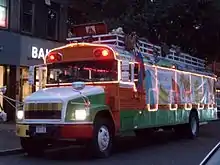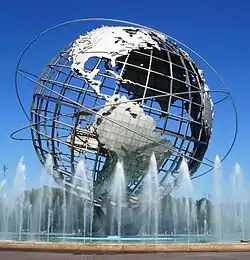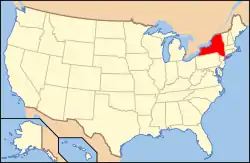Jackson Heights, Queens
Jackson Heights is a neighborhood in the northwestern portion of the borough of Queens in New York City. Jackson Heights is neighbored by North Corona to the east, Elmhurst to the south, Woodside to the west, northern Astoria (Ditmars-Steinway) to the northwest, and East Elmhurst to the northeast. Jackson Heights has an ethnically diverse community, with half the population having been foreign-born since the 2000s. According to the 2010 United States Census, the neighborhood has a population of 108,152.[2]
Jackson Heights | |
|---|---|
Neighborhood of Queens | |
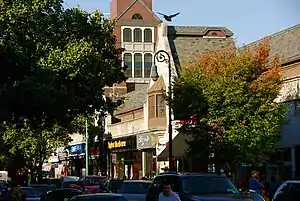 82nd Street in Jackson Heights | |
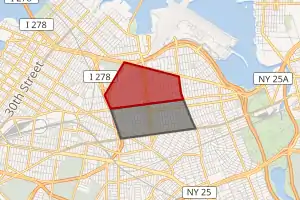
Location within New York City Note: red area overlaps with East Elmhurst. | |
| Country | United States |
| State | New York |
| City | New York City |
| Borough | Queens |
| Community District | Queens 3[1] |
| Population (2010)[2] | |
| • Total | 108,152 |
| Ethnicity | |
| • Hispanic | 56.5% |
| • Asian | 22.0 |
| • White | 17.2 |
| • Black | 2.0 |
| • Other | 2.3 |
| Time zone | UTC−5 (EST) |
| • Summer (DST) | UTC−4 (EDT) |
| ZIP Code | 11372 |
| Area codes | 718, 347, 929, and 917 |
| Website | www |
The site of Jackson Heights was a vast marsh named Trains Meadow until 1909 when Edward A. MacDougall's Queensboro Corporation bought 325 acres (132 ha) of undeveloped land and farms.
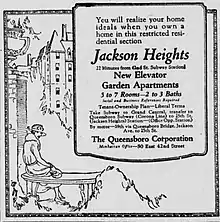
The Queensboro Corporation named the land Jackson Heights after John C. Jackson, a descendant of one of the original Queens families and a respected Queens entrepreneur. Further development arose through the development of transit, and "garden apartments" and "garden homes" soon became prevalent in Jackson Heights. During the 1960s, Jackson Heights' white middle-class families began moving to the suburbs, and non-white residents began moving in.
Jackson Heights retains much of its residential character in the modern day. It also has numerous commercial establishments clustered around 37th Avenue, as well as along several side streets served by subway stations. Much of the neighborhood is part of a national historic district called the Jackson Heights Historic District, which was listed on the National Register of Historic Places in 1999. Part of the neighborhood was placed on a New York City historic district of the same name in 1993.
Jackson Heights is located in Queens Community District 3 and its ZIP Code is 11372.[1] It is patrolled by the New York City Police Department's 115th Precinct.[4] Politically, Jackson Heights is represented by the New York City Council's 21st and 25th districts.[5]
History
Early history
From colonial times to the 1900s, the area now known as Jackson Heights was a vast marsh named Trains Meadow.[6] Urbanization at the turn of the century was creating a New York City housing shortage and urban sprawl. In 1909, Edward A. MacDougall's Queensboro Corporation bought 325 acres (132 ha) of undeveloped land and farms and christened them Jackson Heights after John C. Jackson, a descendant of one of the original Queens families and a respected Queens County entrepreneur.[7][8][9] Northern Boulevard, a major thoroughfare that bisects the neighborhood, was also originally named Jackson Avenue; the name of this road is still retained in a short stretch between Queens Plaza and Queens–Midtown Tunnel in Long Island City.[10] Though the land was not especially known for its elevation, the addition of the term "Heights" echoed the prestige of the neighborhood of Brooklyn Heights and indicated that Jackson Heights was meant to be an exclusive neighborhood.[8][9][11] At that time the area could most easily be reached via a ferry from Manhattan or the Brooklyn Bridge;[11] more direct access came with the Queensboro Bridge in 1909,[12] followed by the elevated IRT Flushing Line—the present-day 7 train, just 20 minutes from Manhattan—in 1917,[13] and the Fifth Avenue Coach Company double-decker coaches in 1922.[12]
Development
Jackson Heights was conceived as a planned development for middle- to upper-middle income workers looking to escape an overcrowded Manhattan. Inspired by Sir Ebenezer Howard's garden city movement,[9][14][15] it was laid out by Edward MacDougall's Queensboro Corporation in 1916 and began attracting residents after the arrival of the Flushing Line in 1917. The Queensboro Corporation coined the name "garden apartment" to convey the concept of apartments built around private parks. Although land for churches was provided, the apartments themselves were limited to White Anglo-Saxon Protestants,[13] excluding Jews, Blacks, and perhaps Greeks and Italians.[16]
Several of the buildings in Jackson Heights were built by the Queensboro Corporation as part of a planned community located a few blocks off of the Flushing Line between Northern Boulevard and 37th Avenue.[17] Targeted toward the middle class,[18] these multi-story apartment buildings designed in the Colonial Revival and neo-Tudor styles were based on similar ones in Berlin.[19] They were to share garden spaces,[20] have ornate exteriors and features such as fireplaces, parquet floors, sun rooms, and built-in bathtubs with showers;[21] and be cooperatively owned.[20] In addition, the corporation divided the land into blocks and building lots, as well as installed streets, sidewalks, and power, water, and sewage lines.[22] The Laurel apartment building on 82nd Street at Northern Boulevard was the first of the Queensboro Corporation buildings in Jackson Heights, completed in 1914 with a small courtyard. The Greystones on either side of 80th Street between 37th and 35th avenues were completed in 1918 with a design by architect George H. Wells. There was leftover unused space, which was converted to parks, gardens, and recreational areas, including a golf course; much of this leftover space, including the golf course, no longer exists.[23] This was followed by the 1919 construction of the Andrew J. Thomas–designed Linden Court, a 10-building complex between 84th Street, 85th Street, 37th Avenue, and Roosevelt Avenue.[24][25] The two sets of 5 buildings each, separated by a gated garden with linden trees and two pathways, included parking spaces with single-story garages accessed via narrow driveways, the first Jackson Heights development to do so; gaps at regular intervals in the perimeter wall; a layout that provided light and ventilation to the apartments, as well as fostered a sense of belonging to a community;[26] the area's first co-op;[27] and now-prevalent private gardens surrounded by the building blocks.[28]
The Hampton Gardens, the Château, and the Towers followed in the 1920s.[29] The Château and the Towers, both co-ops on 34th Avenue, had large, airy apartments and were served by elevators.[24] Prior to 1922, elevators were required to have attendants and more modest buildings were constructed as walk-ups not exceeding five floors. The elegant Château cooperative apartment complex, with twelve buildings surrounding a shared garden, was built in the French Renaissance style and have slate mansard roofs pierced by dormer windows, and diaperwork brick walls.[30] At first purely decorative, the shared gardens in later developments included paved spaces where people could meet or sit.[31] The Queensboro Corporation started the Ivy Court, Cedar Court, and Spanish Gardens projects, all designed by Thomas, in 1924.[32]
The Queensboro Corporation advertised their apartments from 1922 on.[29] On August 28, 1922, the Queensboro Corporation paid $50 to the WEAF radio station to broadcast a ten-minute sales pitch for apartments in Jackson Heights,[33] in what may have been the first "infomercial", opening with a few words about Nathaniel Hawthorne before promoting the corporation's Nathaniel Hawthorne apartments.[34] The ad wanted viewers to:
seek the recreation and the daily comfort of the home removed from the congested part of the city, right at the boundaries of God's great outdoors, and within a few minutes by subway from the business section of Manhattan ... The cry of the heart is for more living room, more chance to unfold, more opportunity to get near Mother Earth, to play, to romp, to plant and to dig ... Let me enjoin upon you as you value your health and your hopes and your home happiness, get away from the solid masses of brick ... where your children grow up starved for a run over a patch of grass and the sight of a tree ... [35]
Built in 1928, the English Gables line 82nd Street, the main shopping area of Jackson Heights' Hispanic community. There are two developments, called English Gables I and II; they were meant to provide a gateway to the neighborhood for commercial traffic and for passengers from the 82nd Street – Jackson Heights station.[10] A year later, the Robert Morris Apartments, on 37th Avenue between 79th and 80th streets, were constructed. Named after Robert Morris, a signer of the United States Declaration of Independence, the apartments have ample green spaces, original high ceilings, and fireplaces, and are relatively expensive.[10][36]
During the Depression, two new buildings were built: Ravenna Court on 37th Avenue between 80th and 81st streets, built in 1929; and Georgian Court three blocks east, between 83rd and 84th streets, built in 1930.[6] The Queensboro Corporation began to build on land that until then had been kept open for community use, including the tennis courts, community garden,[37] and the former golf course—located between 76th and 78th streets and 34th and 37th avenues—all of which were built upon during the 1940s and 1950s.[38] The corporation also began erecting traditional six-story apartment buildings. Dunolly Gardens, the last garden apartment designed by Andrew Thomas, was an exception, a modernistic group of six buildings completed in 1939.[39] The corner windows, considered very innovative in the 1930s, gave the apartments a more spacious feeling, and the landscaped interior courtyard is one of the largest in the historic district.[40] After the 1940s, Jackson Heights' real estate was diversified, with more apartment buildings and cooperatives built with elevators; some new transportation infrastructure were also built.[38]
In 1929, Holmes Airport opened in the northern section of Jackson Heights.[41] Bordering St. Michaels Cemetery to the west, the airfield was also called the Grand Central Air Terminal and Grand Central Airport.[42] Holmes Airport shut down in 1940, one year after LaGuardia Airport opened.[43]
Social and demographic shifts
The neighborhood grew steadily from the 1920s to the 1950s, with construction slowing during the Depression and booming back again after World War II.[44] Holmes Airport operated from 1929 to 1940 on 220 acres (89 ha) adjacent to the community. Later, its land became veterans' housing and the Bulova watch factory site.[45]
Ethnic tensions
By 1930, artists from the Manhattan theater district, many of whom were homosexual, had moved into the area, forming the beginnings of the second largest LGBTQ community in New York outside of Manhattan.[46][47] Jews were allowed to move in by the 1940s. In the 1950s, middle-class businessmen from Colombia, escaping violence and repression in Latin America, brought their financial capital and their families to the community.[8] Following the development of Long Island in the 1960s, Jackson Heights' white middle-class families began moving further out into the suburbs.[8] At the same time the neighborhood experienced an influx of ethnically diverse professionals from Latin America and the Indian subcontinent taking advantage of the 1965 Immigration Reform Act, which allowed them to arrange the immigration of their families.[8][48] White residents' resistance to integration with African-Americans continued late into the decade, and Junction Boulevard came to be called the "Mason-Dixon Line", as it divided Jackson Heights from the black communities in East Elmhurst and Corona.[46]
Crime increases
By the mid-1970s, Roosevelt Avenue had become the neighborhood's commercial center and also gained national attention as a place for organized crime. A 1993 New York Times article detailed how wire transfer services, located in Jackson Heights, inadvertently enabled Colombian cartels to repatriate, and in the process launder, millions of dollars in drug money to South America alongside customers who used the service to transfer legally earned money.[49] The violence that ensued as a result of the growing Jackson Heights illegal drug trade was described by this excerpt from a 1978 New York magazine article titled "Gunfights in the Cocaine Corral":
Over the past three years, in this nice, quiet neighborhood, 27 people have been killed and dozens have been injured.... The violence spreads to surround neighborhoods as cops and prosecutors fight a losing battle. Double and triple homicides go unsolved.[50]
By the late 1980s, Jackson Heights had rising real-estate values and a moderate amount of crime compared to other city neighborhoods.[51] Nevertheless, there were still high-profile crimes that reinforced perceptions of the neighborhood as dangerous. In 1990, Julio Rivera, a gay Puerto Rican man, was murdered in a hate crime. His death galvanized the LGBTQ community into protesting his death with a candlelight vigil, the formation of several LGBTQ activist groups, and the foundation of the Queens Pride Parade.[52] Two years later, journalist Manuel de Dios Unanue was murdered after authoring articles in El Diario La Prensa about the proliferation of Colombian cartels embedded within the business community along Roosevelt Avenue.[53] Seeking to distance themselves from the portrayal of Jackson Heights as a crime-ridden neighborhood, some residents argued that de Dios had been technically murdered in the neighboring Elmhurst, as the restaurant where he was attacked was on the south side of Roosevelt Avenue.[46]
Following the reduction of crime in New York City during the late 1990s, the market for illicit substances that fed the Colombian cocaine industry in Jackson Heights eventually decreased, leading to a reduction in the presence of cartels throughout the neighborhood.[54][55]
Revitalization and 21st century
Community leaders responded to the negative perceptions of Jackson Heights by seeking to have the neighborhood designated as a historic district. In 1988, the Jackson Heights Beautification Group was formed; it organized walking tours as well as beautification activities and commissioned a neighborhood history.[9] Five years later, part of Jackson Heights was made a New York City historic district.[56] The designation, which set architectural guidelines for structures within the designated district, affected both existing buildings and planned new developments within the district.[57]
Starting in the 2000s, Jackson Heights has become once again a desirable destination for professionals and middle-class families. Some of these residents moved to Jackson Heights for the unique architecture of its buildings, while others move for its cultural diversity.[15][58]
Land use
Historic district
Jackson Heights Historic District | |
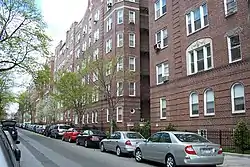 Residential street in Jackson Heights | |
 District position on New York City map  Jackson Heights, Queens (New York)  Jackson Heights, Queens (the United States) | |
| Location | Bounded by Roosevelt Ave., Broadway, Leverich St., 70 St., Northern Blvd., and Junction Blvd., Queens, NYC |
|---|---|
| Coordinates | 40°45′5″N 73°53′13″W |
| Area | 300 acres (120 ha) |
| Architectural style | Late 19th and 20th Century Revivals |
| NRHP reference No. | 99000059[59] |
| NYCL No. | 1831 |
| Significant dates | |
| Added to NRHP | January 27, 1999 |
| Designated NYCL | October 19, 1993 |
Most of the original neighborhood, comprising the garden city apartment buildings, was made a National Register Historic District and a New York State Historic Register District. The Jackson Heights New York State and National Register Districts range from 93rd Street through 69th Street between Northern Boulevard and Roosevelt Avenue. Some property fronting on Northern Boulevard and Roosevelt Avenue, as well as some "cut-outs", are not inside the Register Districts. The national historic district called the Jackson Heights Historic District, includes 2,203 contributing buildings, 19 contributing sites, and three contributing objects. Among the landmarked buildings, over 200 original Queensboro Corporation apartment buildings still exist in Jackson Heights.[60] It was listed on the National Register of Historic Places in 1999.[59]
Almost six hundred buildings in the neighborhood[57]—a rectangle stretching roughly from 76th to 88th Streets and from Roosevelt Avenue almost up to Northern Boulevard—were designated as a New York City Historic District by the New York City Landmarks Preservation Commission on October 19, 1993.[56][61] It comprises large apartment buildings with private communal gardens, as well as many groupings of private homes and many stores on the streets surrounding Roosevelt Avenue.[62][63] Unlike the State and National Districts, the local designation comes with aesthetic protections.
In addition to the Jackson Heights Historic District, the Lent Homestead and Cemetery and Jackson Heights post office are listed on the National Register of Historic Places.[59]
Business district
The main retail thoroughfare is 37th Avenue from 72nd Street to Junction Boulevard, with more retail on 73rd, 74th, and 82nd streets between 37th and Roosevelt avenues.[64] Stores and restaurants on and near 74th Street tend to cater to the large population from the Indian subcontinent in the neighborhood, with sari and jewelry stores, Indian and Bengali music and movie retailers and many restaurants.[65] 37th Avenue contains a wide mix of retailers, including many grocery stores, and 82nd Street contains many national chain stores located in Tudor-style buildings in the Jackson Heights Historic District.[10] South American retailers and eateries, predominantly from Colombia and Peru dominate Northern Boulevard from 80th Street east to the border of neighboring Corona at Junction Boulevard. Roosevelt Avenue is also lined with various mainly Hispanic retail stores.
Street food

Along Roosevelt Avenue from 74th to 108th Streets, street food from all over the world is made and sold though food carts are "currently dominated by the Mexican community."[66] Typical cart food includes Bangladeshi fuchka (phuchka), Middle Eastern lamb over rice, Nepalese momo, Colombian chuzos and arepas, Greek souvlaki, Ecuadorian ceviche, Thai steamed chicken over rice, and Mexican elotes (corn on a cob), tacos, homemade tamales filled with meats, cheese, fruits or even chilies, and fruit batidos or aguas frescas (smoothies) as well as South American sweet churros.[67][68]
In a 2017 episode of his show Parts Unknown, American chef Anthony Bourdain visited several Queens eateries, profiling Evelia Coyotzi, who sells tamales in a street cart on Junction Boulevard, the border between Jackson Heights and neighboring Corona. Bourdain learned about Coyotzi, a Mexican immigrant who spoke no English, through the Street Vendor Project, which advocates for New York City street vendors.[69][70][71]
Other buildings
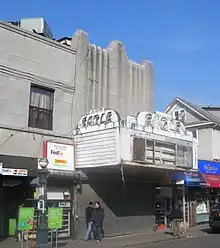
Most housing units in Jackson Heights are apartments in multi-unit buildings, many of which are five or six stories. Many of these buildings are co-ops, some are rentals, and a few are condominiums. There are also a number of one- to three-family houses, most of which are attached row houses.[17] 34th and 35th avenues, as well as most side streets between 37th Avenue and Northern Boulevard, are residential. A section of 90th Street between 30th Avenue and Northern Boulevard was privately developed separately from the Queensboro Corporation. The structures on that stretch of 90th Street are mostly Tudor buildings.[10]
There were five historic movie theaters in Jackson Heights, which are all currently either repurposed or closed.[10] The Art Deco Earle Theater, opened in 1936 on 37th Road between 73rd and 74th streets, was a neighborhood movie theater before becoming a porn theater and then, with the name changed to "Eagle", a Bollywood theater before a strike in the Bollywood industry caused the theater to close permanently in 2009;[10] it is now a food court selling cuisine of the Indian subcontinent.[72] The Fair Theatre, opened in 1939 at Astoria Boulevard and 90th Street, became a porn theater.[10] The Polk Theater, on 37th (formerly Polk) Avenue and 93rd Street, opened in 1938 and closed in 2006, also was a porn theater during its later years, before it was demolished in 2008.[10][73] The Colony Theater, on 82nd Street north of Roosevelt Avenue, opened in 1935 and closed in 1991. The Jackson, afterwards an Indian-owned theater under the name of the Jackson Heights Cinema, on 82nd Street south of Roosevelt Avenue, was demolished in March 2017.[74] Finally, the Boulevard Theater, on Northern Boulevard and 83rd Street, is now a Latin-American restaurant of the same name.
Demographics
Based on data from the 2010 United States Census, the population of Jackson Heights was 108,152, a decrease of 5,175 (4.6%) from the 113,327 counted in 2000. Covering an area of 1,101.36 acres (445.70 ha), the neighborhood had a population density of 98.2 inhabitants per acre (62,800/sq mi; 24,300/km2).[2] The racial makeup of the neighborhood was 17.2% (18,567) White, 2.0% (2,210) African American, 0.1% (145) Native American, 22.0% (23,781) Asian, 0.0% (9) Pacific Islander, 0.5% (583) from other races, and 1.6% (1,736) from two or more races. Hispanic or Latino of any race were 56.5% (61,121) of the population.[3]
The entirety of Queens Community District 3, which comprises Jackson Heights as well as East Elmhurst and North Corona, had 179,844 inhabitants as of NYC Health's 2018 Community Health Profile, with an average life expectancy of 84.7 years.[75]:2, 20 This is higher than the median life expectancy of 81.2 for all New York City neighborhoods.[76]:53 (PDF p. 84)[77] Most inhabitants are middle-aged adults and youth: 22% are between the ages of 0–17, 32% between 25–44, and 24% between 45–64. The ratio of college-aged and elderly residents was lower, at 9% and 12% respectively.[75]:2
As of 2017, the median household income in Community Board 3 was $56,601.[78] In 2018, an estimated 25% of Jackson Heights residents lived in poverty, compared to 19% in all of Queens and 20% in all of New York City. One in fourteen residents (7%) were unemployed, compared to 8% in Queens and 9% in New York City. Rent burden, or the percentage of residents who have difficulty paying their rent, is 59% in Jackson Heights, slightly higher than the boroughwide and citywide rates of 53% and 51% respectively. Based on this calculation, as of 2018, Jackson Heights is considered to be high-income relative to the rest of the city and not gentrifying.[75]:7
However, in 2017, nearly 11% of households in Jackson Heights were severely overcrowded—defined as households in which there are more than 1.5 household members for each room (excluding bathrooms) in the unit—making it the second most overcrowded neighborhood in the city, behind only Elmhurst to the south.[79]
Culture
Jackson Heights is among the most diverse neighborhoods in New York City and the nation. Half of the population was foreign born by the 2000s.[9] Jackson Heights is home to large numbers of South Americans (particularly Colombian, Ecuadorian and Argentinian), Indians, Pakistanis, Tibetans, Nepalese, and Bangladeshis. (Because of its large and vibrant Tibetan community, it has been called "the second (if unofficial) capital of the exile Tibetan world, after Dharamsala, India."[80]) Most businesses are Asian- and Latino-owned, and there are restaurants, bakeries, specialty shops, legal offices, bars, and beauty salons. There is a Little India on 74th Street and a Little Pakistan and Little Bangladesh on 73rd Street.[81] There is also a large concentration of South Americans east of 77th Street, especially a Little Colombia along 37th Avenue.[81]
Jackson Heights was heavily Colombian during the 1980s, but other immigrant groups have settled in the area, notably Mexicans. Many of the displaced Colombians have moved to adjacent areas such as Elmhurst, East Elmhurst, Corona, College Point and Flushing. Queens County still has the largest concentration of Colombians in the United States of any county (roughly 135,000).
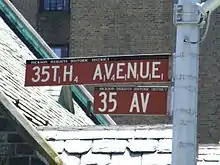
The 2015 documentary In Jackson Heights portrays Jackson Heights as a microcosm of the American melting pot.[82]
The word game Scrabble was co-invented by former architect Alfred Mosher Butts, who lived in Jackson Heights.[83][84] There is a street sign at 35th Avenue and 81st Street that is stylized using letters, with their values in Scrabble as a subscript; it was originally erected in 1995,[85] but after the sign disappeared in 2008,[86] a replacement was put up in 2011.[87]
Community organizations
The Jackson Heights Garden City Society is a historical society, whose founders include local historians, the Queens Borough Historian and local activists. They created and oversee the Jackson Heights Garden City Trail and publish a walking guidebook to Jackson Heights. They also collect artifacts of the community. Periodically, the Society testifies before the New York City Landmarks Preservation Commission on issues of concern to the community.
The 82nd Street Partnership is responsible for the business improvement of the area.[88]
In addition, Colombian broadcaster RCN TV has its US-American headquarters in the neighborhood, reflecting the sizable Colombian population in the area.
There is a year-round greenmarket every Sunday morning at Travers Park, as well as various family-oriented spring and summer concerts.
Early history
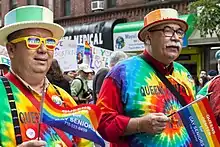
In the 1920s, LGBT actors working in the 42nd Street theater scene decided to make their homes in Jackson Heights due to the lack of affordability of Manhattan neighborhoods and the easy accessibility of the 7 train. That was the beginning of what is now the second largest gay community in New York City.[89]
Until the 1990s, LGBT activities in Jackson Heights were usually held surreptitiously and at night due to a constant fear of backlash. As the neighborhood continued to grow, more spaces for the gay community were added. One of those was the Queens Center for Gay Seniors, which was created using grant money and is still the only senior center in Queens serving the LGBT community specifically.[90][91]
Murder of Julio Rivera
The LGBT community became a movement after the 1990 murder of Julio Rivera, a 29-year-old bartender who worked at the Magic Touch gay bar. Rivera was raised in the Bronx, but tried to avoid the violence of the streets there, and moved to Jackson Heights as an young adult. On the night of July 2, three men cornered Rivera in a schoolyard that was known as a gay cruising area and beat him with a hammer and beer bottle, and then stabbed him.[92] At the beginning of the case, the police department categorized the assault as drug-related, because Rivera had been a longtime cocaine user and they found traces of cocaine on his body. However, after Rivera's friends and relatives advocated for the case to be examined further, the NYPD concluded that Rivera's death had been an anti-gay crime, and the three men involved were charged with murder and manslaughter.[93][94]
If it wasn't for Julio the Queens LGBT movement would not have gotten as far as it has gotten. Julio did not die in vain. He changed people's lives.
— City Councilmember Daniel Dromm, 2015[95]
.jpg.webp)
This was the first real standing for justice and honor for the LGBT community in Queens. The resulting activism led to the Gay and Lesbian Anti-Violence Project, a social services agency that helps monitor any type of criminal acts against the community citywide. Rivera's sister-in-law was elected as the AVP for the LGBT board. Union helped improve the relationship between the Police Department and Jackson Heights' LGBT community and helped with supervision against violence. In 2000, the corner of 78th Street and 37th Avenue, where Rivera was killed, was renamed in his memory[93][96] [97] and a documentary, Julio in Jackson Heights, was made about his murder.[94]
1990s to present
Since the 1990s, the LGBTQ community in Jackson Heights has not only grown in number, but also expanded its diversity and cultures. The Inaugural Queens Lesbian and Gay Parade and Block Party Festival, organized by Daniel Dromm and Maritza Martinez, took place on June 6, 1993, in Jackson Heights, marking a watershed in LGBTQ history. Some 1,000 marchers participated, and thousands of spectators attended. More than a dozen LGBTQ organizations sponsored the event. In 1994 Dromm and activist Wayne Mahlke organized the Lesbian and Gay Democratic Club of Queens, "the only LGBT independent Democratic club in the Borough of Queens."[98] That same year, the Queens Pride Parade commemorated the 25th anniversary of the Stonewall riots. In 1995, Ed Sedarbaum established the SAGE/Queens Clubhouse, the first senior citizens program in Queens to provide outreach to LGBTQ elderly. In 1999, an estimated 40,000 people attend the Queens Pride Parade with some 70 community groups registered.[99]
Daniel Dromm and Jimmy Van Bramer were elected to the New York City Council on November 3, 2009, representing, respectively, the 25th and 26th districts in Queens.[100] Both City Council members are openly gay.[101]
Incidents
On August 15, 2001, Edgar Garzon, a gay man, was murdered in an incident that the Queens district attorney characterized as a "possible hate crime." The murder quickly faded from public attention after the September 11 attacks a month later. In 2006, John L. McGhee was charged with Garzon's murder.[102]
On June 3, 2018, 25-year-old school teacher Brandon Soriano was attacked by two men following the 2018 Pride Parade in what has been deemed a hate crime.[103][104] Five days later, a Latina transgender woman was allegedly stabbed repeatedly a few blocks away.[105]
Economy
US-Bangla Airlines formerly had its U.S. offices in the Bangladesh Plaza building in Jackson Heights.[106]
Parks and recreation
Travers Park is the main local playground. It has a variety of sports, including basketball, tennis, baseball, soccer, and handball.[36] In recent years, a farmers' market was expanded to a year-round presence.[107]
There is also a park named "One Room Schoolhouse Park", named after the last one-room schoolhouse in Queens.[10] The school was at Astoria Boulevard and 90th Street from 1879 to 1934; it became a playground in 1935 and a garden in 1992.[108]
Prior to expansion, the P.S. 69 school yard offered baseball fields, a stickball field, a handball court and three tennis courts. Con Edison sponsored several summer tennis camps at P.S. 69's school yard from 1982 to 1992. In 1998, P.S. 69 built an annex to compensate for the booming population of children in Jackson Heights and the public access to the school yard was removed. However, on November 30, 2011, then-Mayor Michael Bloomberg and other city officials opened the 200th "Schoolyard to Playground" at P.S. 69 as a part of the PlaNYC initiative to ensure all New Yorkers live within a 10-minute walk of a park or playground; the program is turning schoolyards into playgrounds in neighborhoods across the city.[109]
Police and crime
Jackson Heights is patrolled by the 115th Precinct of the NYPD, located at 92–15 Northern Boulevard.[4] The 115th Precinct was ranked 20th safest out of 69 patrol areas for per-capita crime in 2010. Crime has declined significantly since the late 20th century when the area was known as the "cocaine capital" of New York City.[110] As of 2018, with a non-fatal assault rate of 33 per 100,000 people, Jackson Heights's rate of violent crimes per capita is less than that of the city as a whole. The incarceration rate of 342 per 100,000 people is lower than that of the city as a whole.[75]:8
The 115th Precinct has a lower crime rate than in the 1990s, with crimes across all categories having decreased by 85.0% between 1990 and 2019. The precinct reported 11 murders, 42 rapes, 246 robberies, 344 felony assaults, 125 burglaries, 520 grand larcenies, and 128 grand larcenies auto in 2019.[111]
Fire safety
Jackson Heights is served by two New York City Fire Department (FDNY) fire stations.[112] Engine Co. 307/Ladder Co. 154 is located at 81–19 Northern Boulevard.[113] Another fire station, Engine Co. 316, is located at 27–12 Kearney Street in East Elmhurst.[114]
Health
As of 2018, preterm births are about the same in Jackson Heights as in other places citywide, but births to teenage mothers are more common. In Jackson Heights, there were 86 preterm births per 1,000 live births (compared to 87 per 1,000 citywide), and 27.9 births to teenage mothers per 1,000 live births (compared to 19.3 per 1,000 citywide).[75]:11 Jackson Heights has a high population of residents who are uninsured. In 2018, this population of uninsured residents was estimated to be 28%, which is higher than the citywide rate of 12%.[75]:14
The concentration of fine particulate matter, the deadliest type of air pollutant, in Jackson Heights is 0.0073 milligrams per cubic metre (7.3×10−9 oz/cu ft), lower than the city average.[75]:9 Thirteen percent of Jackson Heights residents are smokers, which is slightly lower than the city average of 14% of residents being smokers.[75]:13 In Jackson Heights, 20% of residents are obese, 13% are diabetic, and 29% have high blood pressure—compared to the citywide averages of 20%, 14%, and 24% respectively.[75]:16 In addition, 26% of children are obese, compared to the citywide average of 20%.[75]:12
Eighty-six percent of residents eat some fruits and vegetables every day, which is slightly lower than the city's average of 87%. In 2018, 72% of residents described their health as "good", "very good", or "excellent", lower than the city's average of 78%.[75]:13 For every supermarket in Jackson Heights, there are 17 bodegas. Jackson Heights also has two farmer's markets.[75]:10
The nearest large hospital in the Jackson Heights area is the Elmhurst Hospital Center in Elmhurst.[115]
Incidents
In 2020, the neighborhoods of Corona, East Elmhurst, Elmhurst, and Jackson Heights were most affected by the COVID-19 pandemic in New York City.[116] As of August 10, these communities, with a cumulative 303,494 residents, had recorded 12,954 COVID-19 cases and 1,178 deaths.[117] COVID-19 cases in ZIP Code 11372 were among the highest of any ZIP Code in New York City.[118]
Post offices and ZIP Codes
Jackson Heights is covered by multiple ZIP Codes. The area between Northern Boulevard and Roosevelt Avenue is covered by 11372, while the areas north of Northern Boulevard are covered by 11370 west of 85th Street (an area stretching north to Astoria and Rikers Island) and 11369 east of 85th Street. ZIP Code 11371 is assigned to LaGuardia Airport.[119]
The United States Post Office operates three locations in Jackson Heights:
- Jackson Heights Station – 78-02 37th Avenue[120]
- Junction Boulevard Station – 33-23 Junction Boulevard[121]
- Trainsmeadow Station – 75–77 31st Avenue[122]
Education
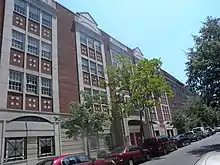
Jackson Heights generally has a lower ratio of college-educated residents than the rest of the city as of 2018. While 27% of residents age 25 and older have a college education or higher, 30% have less than a high school education and 47% are high school graduates or have some college education. By contrast, 39% of Queens residents and 43% of city residents have a college education or higher.[75]:6 The percentage of Jackson Heights students excelling in math rose from 41% in 2000 to 65% in 2011, and reading achievement rose from 46% to 49% during the same time period.[123]
Jackson Heights's rate of elementary school student absenteeism is less than the rest of New York City. In Jackson Heights, 12% of elementary school students missed twenty or more days per school year, lower than the citywide average of 20%.[76]:24 (PDF p. 55)[75]:6 Additionally, 78% of high school students in Jackson Heights graduate on time, more than the citywide average of 75%.[75]:6
Schools
New York City Department of Education operates public schools. Schools in Jackson Heights include P.S. 69 Jackson Heights School,[124] P.S. 149 Christa McAuliffe School,[125] P.S. 212,[126] P.S 222 FF Christopher A. Santora School,[127] I.S. 145 Joseph Pulitzer School,[128] P.S. 152, and I.S. 230.
Charter schools include the Pre-K–12 school Renaissance Charter School.[129]
Private schools in the neighborhood include Saint Joan of Arc School (Pre-K3 to 8 grade), Our Lady of Fatima School (Pre-K to 8 grade), Monsignor McClancy Memorial High School, a school which turned co-ed by the end of the 2012 school year, though technically located in East Elmhurst. Garden School, a private, non-profit 501(c)(3) independent school within Jackson Heights, enrolls 300 students from grades Nursery–Grade 12.
82nd Street Academics, a non-profit 501(c)(3) educational institution, is housed at the Community United Methodist Church of Jackson Heights. Since 2003, it has been a community-based Universal Pre-Kindergarten provider under contract with the New York Department of Education.[130][131]
Library
The Queens Public Library's Jackson Heights branch is located at 35–51 81st Street.[132]
Houses of worship
The community is home to various houses of worship from a wide array of religions.
The Community United Methodist Church, located between 81st and 82nd streets on 35th Avenue,[36] is the oldest Church in Jackson Heights. Founded in 1919, it was dedicated in 1923[133] as part of Queensboro Corporation's planned development.[8] Originally serving the spiritual needs of European-American Protestant residents, it is now the most diverse church in Queens with Chinese, Korean, Spanish, and English services.[8] Reverend Austin Armistead, who led the church from 1974 to 1995, is credited for the church's racial and cultural change. Prior to his arrival in 1974, the suggestion of the Spanish-speaking service had been rejected. Armistead made the decision to remake the church, with a vision of mirroring the neighborhood and so divided the church into four different ministries; the church also came to serve as "common ground" for a range of community groups, from ethnic associations to LGBTQ organizations to nonprofits like the Jackson Heights Beautification Group.[134]
Satya Narayan Mandir, located at NE corner of 76 street and Woodside Avenue, is the oldest Hindu-Sikhism combination temple in the United States (and, it claims, the Americas). It was incorporated in 1987.[135]
Saint Joan of Arc Catholic Church, located between 82nd and 83rd Street on 35th Avenue, was the first Catholic church to be named in honor of a newly canonized French Saint.[136]
Muhammadi Community Center, located at 37–46 72nd Street, serves the Muslim population of Jackson Heights since 1995. Its head and founder is Imam Qazi Qayyoom.[137]
St. Mark's Episcopal Church, located on 34th Avenue between 81st and 82nd streets within the Jackson Heights Historic District, the church offers bilingual worship. It was established in 1923 as part of Queensboro Corporation's planned development. In 1993, it was designated by the New York City Landmarks Preservation Commission.[138]
Jackson Heights-Elmhurst Kehillah, located in the lower level of the Jackson Heights Jewish Center at 77th Street at the corner of 37th Avenue, provides all manner of services for all residents of Jackson Heights, Elmhurst, and western Queens.[139]
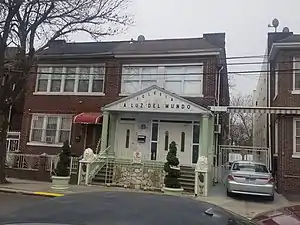 Iglesia La Luz Del Mundo
Iglesia La Luz Del Mundo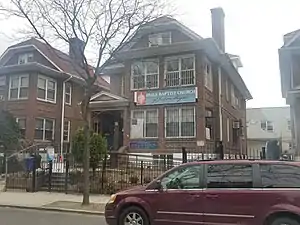 Bible Baptist church of Jackson Heights
Bible Baptist church of Jackson Heights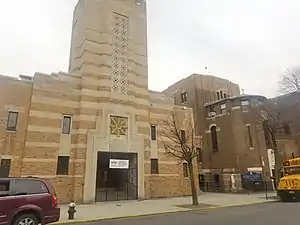 Blessed Sacrements Church
Blessed Sacrements Church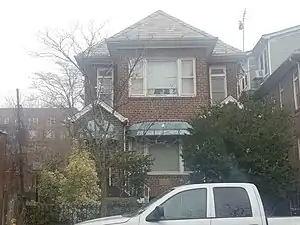 Orthodox American Church
Orthodox American Church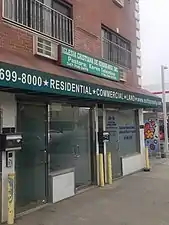 Iglesia Cristiana De Restauracion Jehova Nisi
Iglesia Cristiana De Restauracion Jehova Nisi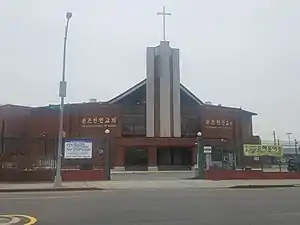 The Korean Church Of Queens
The Korean Church Of Queens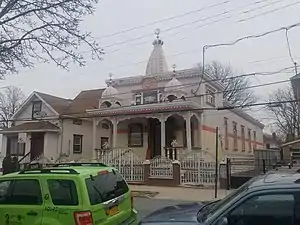 New York Hindu Sanatan Inc
New York Hindu Sanatan Inc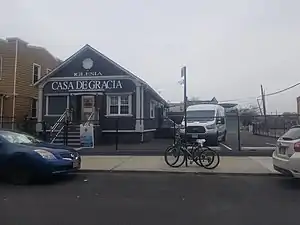 Grace Community Church
Grace Community Church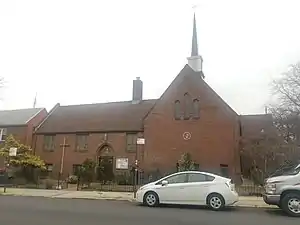 Atonement Lutheran Church & Pre School
Atonement Lutheran Church & Pre School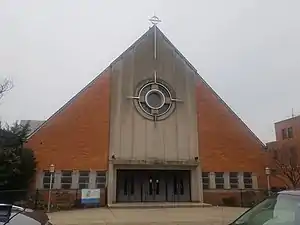 Our Lady of Fatima Church
Our Lady of Fatima Church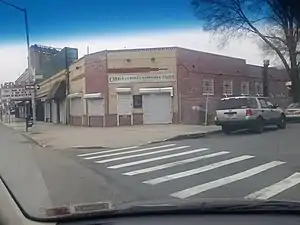 Evangelistic Church - Our Lord
Evangelistic Church - Our Lord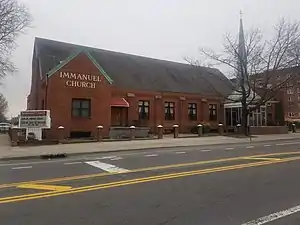 Immanuel Baptist
Immanuel Baptist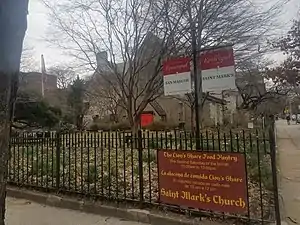 Saint Mark's Espiscopal Church
Saint Mark's Espiscopal Church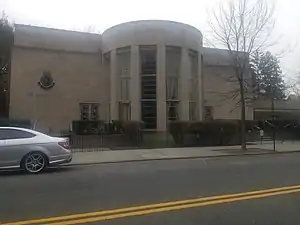 The Salvation Army Queens Temple Corps. Community Center
The Salvation Army Queens Temple Corps. Community Center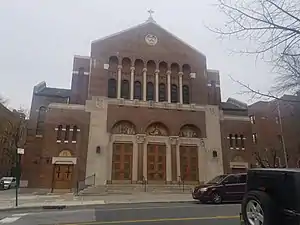 St Joan Of Arc Rc
St Joan Of Arc Rc Community United Methodist
Community United Methodist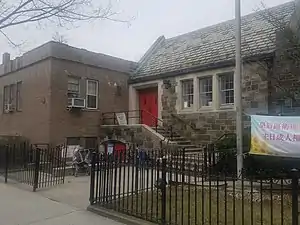 Ray Of Hope Church
Ray Of Hope Church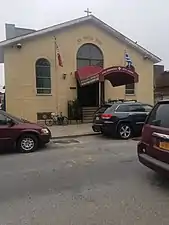 Saint Constantine & Helen Greek Orthodox Church
Saint Constantine & Helen Greek Orthodox Church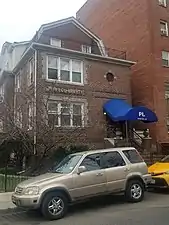 Perfect Liberty Church
Perfect Liberty Church
Transportation
Public transportation
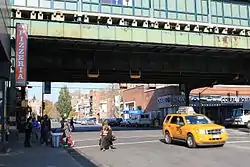
The following New York City Subway stations serve Jackson Heights:[140]
- Jackson Heights–Roosevelt Avenue/74th Street (7, E, F, <F>, M, and R trains)
- 82nd Street–Jackson Heights (7 train)
- 90th Street–Elmhurst Avenue (7 train)
The following MTA Regional Bus Operations bus routes serve Jackson Heights:[141]
- Q32: to Pennsylvania Station in Midtown Manhattan via Roosevelt Avenue and 81st/82nd Streets
- Q33: to East Elmhurst via 82nd/83rd Streets
- Q47: to LaGuardia Marine Air Terminal or Glendale via 73rd/74th Streets
- Q49: to East Elmhurst via 35th Avenue and 89th/90th/92nd Streets
- Q53 SBS: to 61st Street–Woodside (7 and <7> trains)/Woodside LIRR or Rockaway Park–Beach 116th Street (A and S trains) via Roosevelt Avenue and Broadway
- Q66: to Queensboro Plaza (7, <7>, N, and W trains) or Flushing–Main Street (7 and <7> trains) via Northern Boulevard
- Q70 SBS: to 61st Street–Woodside (7 and <7> trains)/Woodside LIRR or LaGuardia Airport Terminals B/C/D via Roosevelt Avenue, Broadway, and Brooklyn-Queens Expressway
- Q72: to 63rd Drive–Rego Park (M and R trains) or LaGuardia Airport Terminals B/C/D via Junction Boulevard
The Jackson Heights–Roosevelt Avenue/74th Street station is a transportation hub where the subway's 7, E, F, <F>, M, and R trains and the Q32, Q33, Q47, Q49. Q53 SBS and Q70 SBS buses converge.[141] The MTA spent over $100 million on renovations to the Jackson Heights bus terminal, which were completed in 2005.[142] It includes one of the first green buildings in the MTA system, the Victor A. Moore Bus Terminal, which is partially powered by solar panels built into the roof. These are located along the length of the sheds above the Flushing Line platforms.[142][48] The terminal, as is the Victor Moore Arcade (which it replaced), is named after Jackson Heights resident Victor Moore, a Broadway and film actor from the era of silent film to the 1950s.[142]
Roads
Interstate 278 (Brooklyn Queens Expressway), New York State Route 25A (Northern Boulevard), and the Grand Central Parkway are major roads in the area. LaGuardia Airport, in neighboring East Elmhurst, is nearby.[141]
Eleven percent of roads in Jackson Heights have bike lanes, similar to the rate in the city overall.[75]:10 These lanes, part of the city's bikeway system, exist on 34th Avenue, as well as on 74th and 75th streets between 34th Avenue and 37th Road. There is also a short one-block bike lane connector on 37th Road between 74th and 75th streets.[143]
Notable residents
- Nadia Ali (born 1980), singer-songwriter.
- Alene S. Ammond (1933–2019), politician known as "The Terror of Trenton", who served in the New Jersey Senate from the 6th Legislative District from 1974 to 1978.[144]
- Alfred Mosher Butts (1899–1993), invented Scrabble in 1938, and perfected it at Community Methodist Church.[145][146]
- Chester Carlson (1906–1968), invented Xerox copy machine in his Jackson Heights kitchen.[147]
- Robert P. Casey (1932–2000), Governor of Pennsylvania from 1987 to 1995.[148]
- Lady Catiria, (1959–1999), drag performer.[149]
- Charlie Chaplin (1899–1977), silent film actor[51]
- Thom Christopher (born 1940), longtime actor on One Life to Live.[150]
- Eleanor Clift (born 1940), Newsweek contributing editor and regular panelist on The McLaughlin Group.[151]
- Montgomery Clift (1920–1966), actor, moved to Jackson Heights with his family in 1933 and lived in The Chateau apartments.[152]
- Ray Dalio (born 1949), founder of Bridgewater Associates.[153]
- Alan M. Davis (born 1949), professor and author.
- David Diosa (born 1992), footballer for the Richmond Kickers in USL League One.[154]
- Edward Djerejian (born 1939), diplomat, former United States Ambassador to Syria and Israel and Assistant Secretary of State.
- Albert K. Dawson (1885–1967), journalist and cinematographer during the First World War.
- Kevin Dobson (born 1943), actor, known for his roles on Kojak and Knots Landing.[155]
- Alfred Eisenstaedt (1898–1995), photographer, lived in Jackson Heights for many years.[156]
- Douglas Fairbanks (1883–1939), actor, screenwriter, director, and producer[51]
- Calvin Fixx (1906—1950), editor at Time magazine.[157]
- Dave Fleming (born 1969), MLB pitcher who spent most of his career with the Seattle Mariners.[158]
- Paul D. Ginsberg (born 1962), President of Roark Capital Group.
- Arthur Googy (born 1961 as Joseph McGuckin), original drummer for the band The Misfits.
- Bobby Hackett (1915–1976), trumpet player who played with Henry Mancini, Benny Goodman, and Louis Armstrong
- Ed Hayes (born 1947), influential lawyer, journalist, and memoirist.[159]
- Helen Kane (1904–1966), singer, known for her baby talk version of I Wanna Be Loved by You and model for Betty Boop.[160]
- Evelyn Fox Keller (born 1936), physicist, author and feminist, who is Professor Emerita of History and Philosophy of Science at the Massachusetts Institute of Technology.[161]
- Richard Kline (born 1944), actor who played Jack's friend Larry on Three's Company.[162]
- John Leguizamo (born 1964), comedian, actor.[163]
- Willy Ley (1906–1969), space writer and theorist.[164]
- Lucy Liu (born 1968), actress.[165]
- Clive Lythgoe (1927–2006), classical pianist.[166]
- John McWhorter (1965–), linguist and author. [167]
- Victor Moore (1876–1962), actor.
- Billy Murcia (1954–1972), original drummer for the New York Dolls.[168]
- Carroll O'Connor (1924—2001), actor, director, producer[51]
- Colby O'Donis (born 1989), pop and R&B singer-songwriter, guitarist, producer and actor.
- Jakiw Palij (born 1923), former Nazi concentration camp guard; emigrated to U.S. in 1949, deported in 2018 at age of 95.[169]
- Les Paul (1915–2009), jazz guitarist and guitar innovator.[170]
- Duncan Penwarden (1880–1930), actor.[171]
- Joe Quesada (born 1962), Editor-in-Chief of Marvel Comics.[172]
- Tommy Rettig (1941–1996), actor who appeared on the 1950s Lassie television series.[173]
- Don Rickles (1926–2017), comedian.[174]
- Robert Tripp Ross (1903–1981), Congressman and former Assistant Secretary of Defense from 1954 to 1957.[175]
- Mercedes Ruehl (born 1948), actress.[176]
- Zoe Saldana (born 1978), actress[177]
- Susan Sarandon (born 1946), actress.[178]
- Eddie August Schneider (1911–1940), record-setting early aviator.[179]
- Walter Sear (1930–2010), audio engineer.[180]
- Gene Simmons (born 1949), of the rock group Kiss.[181]
- Howard Stern (born 1954), host of The Howard Stern Show.[182]
- Bruce Sussman (born 1949), songwriter, best known for his work with Barry Manilow.[183]
- Maria Terrone, poet and writer.[184][185]
- Sada Thompson (1927–2011), award-winning actress.[186]
- Johnny Thunders (1952–1991), of the New York Dolls.
- Waddy Wachtel (born 1947), session guitarist.[187]
- Raees Warsi (born 1963), Urdu poet, writer and TV anchor.
- Helene White (born 1954), federal judge on the United States Court of Appeals for the Sixth Circuit.[188]
In popular culture
- Much of the Alfred Hitchcock film The Wrong Man (1956) takes place within a few blocks of the intersection of Broadway and 74th Street.[189]
- The theme song of the TV show Car 54 Where Are You? (1961–63) has a line that goes: "There's a traffic jam in Harlem that's backed up to Jackson Heights".[190]
- Ingrid Bergman's character Stephanie Dickinson in the movie Cactus Flower (1969) lives in Jackson Heights.
- In Cagney & Lacey (1988), the fictional character Mary Beth Lacey and her family live in an apartment in Jackson Heights.[191]
- In Coming to America (1988), the fictional singer Randy Watson is referred to as "Jackson Heights' own".
- Jackson Heights is mentioned in Del Amitri's song "Surface of the Moon", from the 1992 album Change Everything.
- Part of The Usual Suspects (1995) was filmed in Jackson Heights around 34th Avenue and 82nd Street.
- Portions of Random Hearts (1999) were filmed in Jackson Heights on 35th Avenue between 76th and 77th streets.
- Major portions of the Academy Award–nominated Maria Full of Grace (2004) were filmed on location in Jackson Heights.
- It is also the setting for the TV show Ugly Betty (2006–10), where Betty and her family live.[192]
- Parts of director James Gray's We Own the Night (2007) were filmed between 32nd Avenue and 31st Avenue on 84th Street.
- The eponymous Pakistani drama Jackson Heights is set in this neighborhood and deals with the lives of Pakistanis living in New York City.[193]
- In season 5 of AMC's Mad Men (2012), Ken Cosgrove and his family reside in Jackson Heights
- The documentary film In Jackson Heights (2015) by Frederick Wiseman explores the diversity of people in the neighborhood.[194]
- The HBO series The Night Of (2016) was partially filmed around 37th Avenue and 74rd Street.[195]
See also
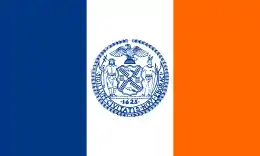 New York City portal
New York City portal
References
Notes
- "NYC Planning | Community Profiles". communityprofiles.planning.nyc.gov. New York City Department of City Planning. Retrieved April 7, 2018.
- Table PL-P5 NTA: Total Population and Persons Per Acre – New York City Neighborhood Tabulation Areas*, 2010, Population Division – New York City Department of City Planning, February 2012. Accessed June 16, 2016.
- Table PL-P3A NTA: Total Population by Mutually Exclusive Race and Hispanic Origin – New York City Neighborhood Tabulation Areas*, 2010, Population Division – New York City Department of City Planning, March 29, 2011. Accessed June 14, 2016.
- "NYPD – 115th Precinct". www.nyc.gov. New York City Police Department. Retrieved October 3, 2016.
- Current City Council Districts for Queens County, New York City. Accessed May 5, 2017.
- Walsh, Kevin (April 2006). "JACKSON HEIGHTS and EAST ELMHURST, Queens". Forgotten NY. Retrieved May 14, 2015.
- Marzlock, Ron. "Jackson Ave. and its namesake". Queens Chronicle. November 21, 2013.
- Miyares, Ines M. (April 21, 2010). "From Exclusionary Covenant to Ethnic Hyperdiversity in Jackson Heights, Queens". Geographical Review. 94 (4): 462–483. doi:10.1111/j.1931-0846.2004.tb00183.x. ISSN 0016-7428. S2CID 129884321.
- Kasinitz, Bazzi & Doane 1998, pp. 161–177
- Walsh, Kevin (April 2006). "JACKSON HEIGHTS and EAST ELMHURST, Queens". Forgotten NY. Retrieved May 14, 2015.
- Hood 2004, p. 173
- Jackson 2010, p. 3100.
- Maly 2005, p. 105.
- Karatzas, Daniel (1990). Jackson Heights: A Garden in the City. Privately printed
- Nevius, James (April 19, 2017). "The transformation of Jackson Heights". Curbed NY. Retrieved April 1, 2019.
- Shukla 2003, p. 89.
- Samways, Maggie. "New York's Most Diverse Neighborhood". Time Out New York.
- Plunz 1990, p. 131.
- Plunz 1990, p. 138.
- Shukla 2003, p. 88.
- Hood 2004, p. 176.
- Hood 2004, p. 175.
- Plunz 1990, p. 139.
- Plunz 1990, p. 141.
- "Linden Court coop buildings one of the earliest cooperatives built in 1919 in the Historic District of Jackson Heights, NY". JACKSON HEIGHTS GARDENS • Real Estate Resource.
- Urbanelli & Robins 1993, p. 3.
- Urbanelli & Robins 1993, p. 4.
- New York City Landmarks Preservation Commission, Dolkart & Postal 2009, p. 300.
- "History of Jackson Heights – A Garden City"; originally from Jeffrey A. Saunders's The Jackson Heights Garden City Trail, published by The Jackson Heights Garden City Society, Inc.
- New York City Landmarks Preservation Commission, Dolkart & Postal 2009, p. 299.
- Plunz 1990, p. 146.
- Urbanelli & Robins 1993, p. 16.
- Barnouw 1966, p. 110.
- Lindsay 2005, p. 339.
- Barnouw 1966, p. 111.
- "Jackson Heights". macaulay.cuny.edu. March 13, 2014. Retrieved May 15, 2015.
- Hood 2004, p. 178.
- "History of Jackson Heights – A Garden City"; originally from Jeffrey A. Saunders's The Jackson Heights Garden City Trail, published by The Jackson Heights Garden City Society, Inc.
- New York City Landmarks Preservation Commission, Dolkart & Postal 2009, p. 298.
- White, Willensky & Leadon 2010, p. 768.
- "SUNDAY THRONGS PACK NEW HOLMES AIRPORT; Crowd Put at 100,000 Views the Queens Flying Field—Many Planes Try Out Runways". The New York Times. March 18, 1929. ISSN 0362-4331. Retrieved December 30, 2019.
- "Abandoned & Little-Known Airfields: New York City, Queens". www.airfields-freeman.com. Retrieved June 12, 2017.
- Stoff, Joshua (2004). Long Island Airports. Arcadia Publishing. pp. 85–86. ISBN 0-7385-3676-8.
- "Jackson Heights History". MPC Properties. Retrieved March 30, 2019.
- "Untapped Mailbag: What Were the Boundaries of Holmes Airport (now Bulova Building) in Queens?". Untapped Cities.
- Maly, Michael T. "Chapter 4: Jackson Heights." Beyond Segregation: Multiracial and Multiethnic Neighborhoods in the United States, Temple University Press, 2011.
- "Starting Point of First Queens Pride Parade". NYC LGBT Historic Sites Project. Retrieved April 1, 2019.
- Cerquera, Yolian (November 2, 2012). "Is Jackson Heights New York's Most Eclectic Neighborhood?". Highbrow Magazine. Retrieved May 14, 2015.
- Fisher, Ian (June 17, 1993). "A Window on Immigrant Crime; In Jackson Heights, Drugs, Dirty Money and Prostitution". The New York Times. ISSN 0362-4331. Retrieved March 26, 2019.
- Kasinitz, Philip; Bazzi, Mohamad; Doane, Randal (1999). "Jackson Heights, New York". SSRN Working Paper Series. doi:10.2139/ssrn.149448. ISSN 1556-5068. S2CID 150549375.
- Fullam, Anne (December 2, 1987). "If You're Thinking of Living in:; Jackson Heights". The New York Times. ISSN 0362-4331. Retrieved April 25, 2020.
- The Lavender Line: Coming Out in Queens. Eds. Stephen Petrus and Soraya Ciego-Lemur. LaGuardia and Wagner Archives, LaGuardia Community College/CUNY, 2018.
- Fisher, Ian (May 11, 1993). "Jackson Heights Streets Familiar to Drug Cartels". The New York Times. ISSN 0362-4331. Retrieved March 26, 2019.
- Letwin, Michael (1990). "Report from the Front Line: The Bennett Plan, Street-Level Drug Enforcement in New York City and the Legalization Debate" (PDF). Hofstra Law Review. 18:795: 795–830.
- "What Reduced Crime in New York City". www.nber.org. Retrieved March 26, 2019.
- "Jackson Heights Tract Named Historic Area". The New York Times. October 2, 1993. ISSN 0362-4331. Retrieved April 25, 2020.
- Oser, Alan S. (February 6, 1994). "PERSPECTIVES; In Jackson Heights, a New Building Evokes the Past". The New York Times. ISSN 0362-4331. Retrieved April 25, 2020.
- Trapasso, Clare. "Woodside, Jackson Heights, Elmhurst become more desirable neighborhoods". nydailynews.com. Retrieved April 1, 2019.
- "National Register Information System". National Register of Historic Places. National Park Service. March 13, 2009.
-
- Kathleen LaFrank (April 1998). "National Register of Historic Places Registration: Jackson Heights Historic District". New York State Office of Parks, Recreation and Historic Preservation. Retrieved January 16, 2011.
- "Accompanying 36 photos".
- Braine 2009, p. 2.
- Myers, Steven Lee. "Council Votes Historic District In 38-Block Section of Queens", The New York Times, January 27, 1994. Accessed August 20, 2009.
- "Map of the District" (PDF). Nyc.gov. Archived from the original (PDF) on March 2, 2010. Retrieved November 11, 2017.
- Daniel Maurer "Stretching $50 in Jackson Heights." New York Magazine
- Myers, Steven Lee (January 4, 1993). "Bazaar With the Feel of Bombay, Right in Queens". The New York Times. ISSN 0362-4331. Retrieved August 12, 2016.
- Miyares, Ines M. "From Exclusionary Covenant to Ethnic Hyperdiversity in Jackson Heights, Queens." Geographical Review, vol. 94, no. 4, Oct. 2004, pp. 462–483
- Schwartz, Daniel (April 30, 2018). "These Street Food Tours Take You Places Others Don't, Like the Heart of Queens". Fathomaway.com. Retrieved March 25, 2019.
- Dai, Serena (May 18, 2017). "Bourdain on Queens: 'This is a Wonderland' Because of Street Food". Eater NY. Retrieved March 25, 2019.
- Rorke, Robert (May 20, 2017). "Anthony Bourdain takes 'Parts Unknown' to his Queens backyard". New York Post. Retrieved March 29, 2019.
- Sietsema, Robert (May 22, 2017). "Eat Like Anthony Bourdain in Queens—Without the Lines". Eater NY. Retrieved March 29, 2019.
- "Queens Restaurateurs Remember, Thank Anthony Bourdain". Jackson Heights-Elmhurst, NY Patch. June 8, 2018. Retrieved March 29, 2019.
- "Former Eagle Theater in Jackson Heights Reopens As Food Court". DNAinfo New York. Archived from the original on May 18, 2015.
- "The Polk Theatre is part of film history". Nydailynews.com. Retrieved November 11, 2017.
- "Credits Roll for Jackson Heights Cinema After Rent Dispute". DNAinfo New York. Archived from the original on May 18, 2015.
- "Jackson Heights (Including East Elmhurst, Jackson Heights and North Corona)" (PDF). nyc.gov. NYC Health. 2018. Retrieved March 2, 2019.
- "2016–2018 Community Health Assessment and Community Health Improvement Plan: Take Care New York 2020" (PDF). nyc.gov. New York City Department of Health and Mental Hygiene. 2016. Retrieved September 8, 2017.
- "New Yorkers are living longer, happier and healthier lives". New York Post. June 4, 2017. Retrieved March 1, 2019.
- "NYC-Queens Community District 3—Jackson Heights & North Corona PUMA, NY". Census Reporter. Retrieved July 17, 2018.
- "Part 3: Indicators, Rankings, and Methods." State of New York City's Housing & Neighborhoods – 2017 Report. NYU Furman Center, 2017, p.122
- Dorjee, Tenzin (June 2017). "Obituary: Elliot Sperling (1951–2017)". Himalaya: The Journal of the Association for Nepal and Himalayan Studies. 37 (1). Retrieved July 5, 2020.
- Braine 2009, p. 1.
- "Watch Full Episodes Online of In Jackson Heights on PBS". Pbs.org. Retrieved August 24, 2017.
- Roleke, John. "Scrabble Avenue: Scrabble Invented in Jackson Heights". About.com.
- Kershaw, Sarah. "NEIGHBORHOOD REPORT: JACKSON HEIGHTS;Rewriting The Story Of Scrabble", The New York Times, October 1, 1995. Retrieved May 28, 2009.
- Kershaw, Sarah (October 1, 1995). "NEIGHBORHOOD REPORT: JACKSON HEIGHTS;Rewriting The Story Of Scrabble". The New York Times. ISSN 0362-4331. Retrieved April 25, 2020.
- Ember, Sydney (July 15, 2011). "For a Bereft Street Corner in Queens, a Red-Letter Day". The New York Times. Retrieved November 23, 2014.
- "Historic Scrabble Sign Makes Triumphant Return To Jackson Heights". Queens Gazette. October 26, 2011. Archived from the original on October 6, 2015. Retrieved November 23, 2014.
- "Welcome to 82nd Street – Jackson Heights & Elmhurst, Queens". Retrieved August 11, 2020.
- Maly, Michael T. "Chapter 4: Jackson Heights." Beyond Segregation: Multiracial and Multiethnic Neighborhoods in the United States, Temple University Press, 2011
- Iceland, J. (March 1, 2007). "Beyond Segregation: Multiracial and Multiethnic Neighborhoods in the United States By Michael T. Maly Temple University Press, 2005. 278 pages. $68.50 (cloth), $22.95 (paper)". Social Forces. 85 (3): 1444–1446. doi:10.1353/sof.2007.0041. ISSN 0037-7732. S2CID 201742462.
- "L.G.B.T. Senior Citizens Find Safe Haven at Jackson Heights Community Center | The New York Times Student Journalism Institute". Retrieved April 2, 2019.
- Stanley, Alessandra (November 18, 1991). "The Symbols Spawned by a Killing". The New York Times. Retrieved March 27, 2019.
- "At Site of Gay Man's Murder, a Street Corner Acknowledges Its Past". The New York Times. March 21, 2016. Retrieved March 27, 2019.
- "Julio Rivera and the Making of a Hate Crime". NPR.org. June 24, 2016. Retrieved March 27, 2019.
- "Julio Rivera Corner". NYC LGBT Historic Sites Project. Retrieved March 27, 2019.
- "Over 40,000 Attend Our Largest Pride Day Events Ever! Queens Pride Guide 2000. LaGuardia and Wagner Archives, LaGuardia Community College.
- "Julio Rivera Corner". NYC LGBT Historic Sites Project. Retrieved March 27, 2019.
- "Lesbian and Gay Democratic Club of Queens". www.lgdcq.nyc. Retrieved April 4, 2019.
- From Out and About: LGTBQ Life in NYC. 2019 Calendar. LaGuardia and Wagner Archives, LaGuardia Community College, Queens, New York, 2019.
- "New York City Council – Election Results 2009". The New York Times. November 9, 2009. Retrieved September 29, 2019.
- "Van Bramer Hosts Drag Queen Story Hour in Jackson Heights, Celebrate Program's Funding". LIC Post. July 26, 2019. Retrieved September 29, 2019.
- Fahim, Kareem (June 30, 2006). "Stepping Off Plane, Man Is Arrested in '01 Queens Murder". The New York Times. ISSN 0362-4331. Retrieved April 4, 2019.
- "Homophobic Attack Mars Otherwise Jubilant Queens Pride Parade". Jackson Heights Post. June 4, 2018. Retrieved April 4, 2019.
- "'Homophobia Is Real:' Man, 25, Attacked By Pair Of Strangers In Potential Hate Crime Following Queens Pride Parade". June 4, 2018. Retrieved April 4, 2019.
- Hern, Katherine; ez. "LGBTQ Activists Rally In Jackson Heights Following Recent Attacks". Gothamist. Archived from the original on April 4, 2019. Retrieved April 4, 2019.
- "Contact Us Archived March 13, 2018, at the Wayback Machine." US-Bangla Airlines. Retrieved on September 6, 2017. "USA Office Bangladesh Plaza 37-15 73ST Suite-202 Jackson Heights, NY-11372"
- "Jackson Heights Greenmarket is boro's first year-round". NY Daily News. Retrieved February 19, 2018.
- "One Room Schoolhouse Park". nycgovparks.org.
- "NYC.gov". NYC.gov. November 30, 2011. Retrieved November 11, 2012.
- "Jackson Heights & East Elmhurst – DNAinfo.com Crime and Safety Report". www.dnainfo.com. Archived from the original on April 15, 2017. Retrieved October 6, 2016.
- "115th Precinct CompStat Report" (PDF). www.nyc.gov. New York City Police Department. Retrieved March 16, 2020.
- "FDNY Firehouse Listing – Location of Firehouses and companies". NYC Open Data; Socrata. New York City Fire Department. September 10, 2018. Retrieved March 14, 2019.
- "Engine Company 307/Ladder Company 154". FDNYtrucks.com. Retrieved March 7, 2019.
- "Engine Company 316". FDNYtrucks.com. Retrieved March 7, 2019.
- Finkel, Beth (February 27, 2014). "Guide To Queens Hospitals". Queens Tribune. Archived from the original on February 4, 2017. Retrieved March 7, 2019.
- Correal, Annie; Jacobs, Andrew; Jones, Ryan Christopher (April 9, 2020). "'A Tragedy Is Unfolding': Inside New York's Virus Epicenter". The New York Times. ISSN 0362-4331. Retrieved April 9, 2020.
- "COVID-19 Data by ZIP Code of Residence". City of New York. August 10, 2020. Retrieved August 10, 2020.
- Brand, David (May 19, 2020). "COVID rates in six Queens zip codes reveal lethal impact on communities of color". Queens Daily Eagle. Retrieved June 14, 2020.
- "Jackson Heights, New York City-Queens, New York Zip Code Boundary Map (NY)". United States Zip Code Boundary Map (USA). Retrieved March 8, 2019.
- "Location Details: Jackson Heights". USPS.com. Retrieved March 7, 2019.
- "Location Details: Arverne". USPS.com. Retrieved March 7, 2019.
- "Location Details: Trainsmeadow". USPS.com. Retrieved March 7, 2019.
- "Jackson Heights – QN 03" (PDF). Furman Center for Real Estate and Urban Policy. 2011. Retrieved October 5, 2016.
- "P.S. 69 Jackson Heights School School Review Archived November 29, 2014, at the Wayback Machine". Inside Schools. Retrieved on December 17, 2009.
- "P.S. 148, Christa McAuliffe School School Review Archived November 29, 2014, at the Wayback Machine". Inside Schools. Retrieved on December 17, 2009.
- "P.S. 212 School Review Archived November 29, 2014, at the Wayback Machine". Inside Schools. Retrieved on December 17, 2009.
- "P.S 222 FF Christopher A. Santora School School Review Archived November 29, 2014, at the Wayback Machine". Inside Schools. Retrieved on December 17, 2009.
- "I.S. 145 Joseph Pulitzer School School Review Archived August 13, 2010, at the Wayback Machine". Inside Schools. Retrieved on December 17, 2009.
- "Renaissance Charter School School Review Archived June 13, 2010, at the Wayback Machine". Inside Schools. Retrieved on December 17, 2009.
- "82nd Street Academics". privateschoolreview.com.
- 82nd Street Academics Archived August 4, 2012, at the Wayback Machine
- "Branch Detailed Info: Jackson Heights". Queens Public Library. Retrieved March 7, 2019.
- "History". Community United Methodist Church. Retrieved April 4, 2019.
- Maly, Michael (January 19, 2011). Beyond Segregation: Multiracial And Multiethnic Neighborhoods. Temple University Press. ISBN 9781592131365.
- "::About Mandir". satyanarayanmandir.org. Retrieved April 4, 2019.
- Blog, McNamara's (May 30, 2014). "Queens Parish First One Named for St. Joan of Arc, 1920". McNamara's Blog. Retrieved March 27, 2019.
- "Islam | Exploring Diversity in Jackson Heights". eportfolios.macaulay.cuny.edu. Retrieved April 4, 2019.
- "St. Mark's Episcopal Church – Jackson Heights (Queens), NY". www.nycago.org. Retrieved April 4, 2019.
- "Jackson Heights-Elmhurst Kehillah". www.jhekehillah.org. Retrieved April 4, 2019.
- "Subway Map" (PDF). Metropolitan Transportation Authority. October 21, 2019. Retrieved January 18, 2018.
- "Queens Bus Map" (PDF). Metropolitan Transportation Authority. September 2019. Retrieved December 1, 2020.
- "Officials Applaud Opening Of Renovated Bus Terminal | www.qgazette.com | Queens Gazette". www.qgazette.com. July 20, 2005. Archived from the original on March 22, 2012. Retrieved November 11, 2012.
- "NYC DOT – Bicycle Maps". Nyc.gov. Retrieved November 11, 2017.
- Moran, Robert. "Alene S. Ammond, 86, N.J. state senator during 1970s who fought for legislative accountability", The Philadelphia Inquirer, June 14, 2019. "Sen. Ammond was born in Jackson Heights, Queens".
- Kershaw, Sarah. "Inside Queens; A Criss-Crossed Quest", The New York Times, October 1, 1995. Accessed October 19, 2007. "Jeffrey A. Saunders knew that Scrabble was born on 79th Street in Jackson Heights. He knew that Alfred Mosher Butts lived there when he invented the game."
- Clare Trapasso, "New 'Scrabble' street sign will go up in Queens to commemorate birthplace of board game," New York Daily News (July 21, 2011).
- Abadjian, Nick. "Inventors of Queens" Archived December 20, 2007, at the Wayback Machine, Queens Tribune, May 22, 2003. Accessed December 17, 2007. "Carlson, a Jackson Heights resident, worked as a lab researcher for a year and got laid off."
- Molotsky, Irvin. "Former Gov. Robert P. Casey Dies at 68; Pennsylvania Democrat Opposed Abortion", The New York Times, May 31, 2000. Accessed May 28, 2009.
- Suggs, Donald (June 1, 1999). "Queen of Hearts". POZ. Retrieved April 30, 2017.
- "Thom Christopher", Soap Opera Digest. Accessed May 28, 2009. "Native New Yorker Thom Christopher hails from the Queens neighborhood of Jackson Heights."
- Solomon, Deborah. "Questions for Eleanor Clift: Grande Dame", The New York Times, March 2, 2008. Accessed May 28, 2009. "Where are you from? I grew up in Jackson Heights, Queens, and my father had a deli, Roeloffs Deli, in Sunnyside."
- Bosworth, Patricia. "Montgomery Clift: A Biography", p. 47. Hal Leonard Corporation, 2007. ISBN 0-87910-135-0.
- Cassidy, John. "Mastering the MachineHow Ray Dalio built the world's richest and strangest hedge fund", The New Yorker, July 25, 2011. Accessed June 16, 2016. "The only child of Italian-American parents, Ray Dalio was born in Jackson Heights, Queens, in 1949."
- Diaz, Cesar. "Cosmos kick off, with Queens’ help; Jackson Heights-born David Diosa is ready to begin the new season", Queens Chronicle, April 16, 2015. Accessed December 3, 2020. "Come Saturday, New York Cosmos fans from the five boroughs and beyond can see Jackson Heights native David Diosa, 23, who enters his fifth year with the team, play at the club’s home opener at Hofstra’s James M. Shuart Stadium in Hempstead, LI."
- "Hollywood Freeway", Los Angeles Daily News, July 17, 1990. Accessed May 28, 2009. "When you grow up in the projects in Jackson Heights, in the New York borough of Queens, you don't think about having a golf and tennis tournament named after you. You only think about getting out and surviving. Kevin Dobson got out."
- Grundberg, Andy. "Alfred Eisenstaedt, 90: The Image of Activity", The New York Times, November 12, 1998. Accessed September 25, 2007. "Until a year ago, he would walk daily from his home in Jackson Heights, Queens, to his office on the Avenue of the Americas and 51st Street, he said."
- "Calvin Fixx", The New York Times, March 4, 1950. Accessed December 20, 2016. ""Calvin Fixx of 33–28 Eighty-first Street, Jackson Heights, Queens, a member of the special projects department of Time, Inc., and a former editor of Time, died yesterday of a heart ailment in the Atlantic City Hospital, according to word received here."
- Street, Jim. "Where've you gone, Dave Fleming?" Archived March 7, 2009, at the Wayback Machine, Seattle Mariners, June 10, 2003. Accessed May 28, 2009. "The ace of the '92 staff was Dave Fleming, a quiet southpaw born in the Jackson Heights section of Queens, N.Y., who went from College World Series star at the University of Georgia to the Major Leagues in a blink of an eye."
- McGrath, Charles. "The Fixer", The New York Times, February 19, 2006. Accessed October 22, 2009.
- via Associated Press. "Obituary: Helen Kane", Toledo Blade, September 27, 1966. Accessed May 28, 2009.
- Dean, Cornelia. "Theorist Drawn Into Debate 'That Will Not Go Away'", The New York Times, April 12, 2005. Accessed November 27, 2017. "Dr. Keller, whose honors and fellowships include a MacArthur award in 1992 (she used the money to buy a house on Cape Cod), was born in Jackson Heights, Queens, in 1936, the daughter of Russian immigrants. She grew up in Woodside, graduated with a degree in physics from Brandeis and went on to Harvard."
- "A Californian Teaches NY Something About Jewishness", Playbill, February 26, 1997. Accessed June 16, 2016. "Once upon a time in Jackson Heights, N.Y., there lived an 11-year-old Little League baseball player named Richard Klein. This baseball player, when he grew up and became an actor, had to change his name to Richard Kline because there already was another actor named Richard Klein."
- Zook, Kristal Brent. "Comedy That Hits Close to Home; Now a Father, John Leguizamo Looks Back Without Anger", The Washington Post, July 19, 2001. Accessed June 11, 2009. "Born in Bogota, Colombia, to a Puerto Rican father and a Colombian mother of Indian ancestry, [John Leguizamo] was raised in the multiethnic Jackson Heights neighborhood of Queens."
- via United Press International. "Space Scientist Willy Ley Dies", Milwaukee Sentinel, June 25, 1969. Accessed May 28, 2009.
- Ogunnaike, Lola. "The Perks and Pitfalls Of a Ruthless-Killer Role; Lucy Liu Boosts the Body Count in New Film", The New York Times, October 13, 2003. Accessed October 25, 2007. "Born in Jackson Heights, Queens, Ms. Liu, the daughter of working-class Chinese immigrants, recalled many an afternoon spent parked in front of a television set."
- Blumenthal, Ralph. "Most of His Audience Is Homeless; Clive Lythgoe, a Piano Virtuoso, Now Likes Life at a Different Tempo", The New York Times, October 9, 2000. Accessed May 28, 2009. "Mr. Lythgoe's life these days is a far cry from his glamorous existence as a fast-rising star. Instead of a six-bedroom manor in Sussex, he lives alone in a simple one-bedroom co-op apartment in Jackson Heights, Queens."
- "Conversations with Tyler: John McWhorter on Linguistics, Music, and Race (Live at Mason)". cowenconvos.libsyn.com. Retrieved February 4, 2021.
- Jacobson, Mark. "The Icon: Doll Face", New York, September 23, 2002. Accessed May 28, 2009. "Then came the sad pictures: Johnny and Jerry, RIP, and Billy Murcia too, their first drummer, a Colombian from Jackson Heights, dead in a London bathtub."
- "Nazi collaborator Jakiw Palij is deported from U.S. to Germany". NBC News. August 21, 2018. Retrieved September 10, 2018.
- Buskin, Richard. "Classic Tracks: Les Paul & Mary Ford 'How High The Moon'", Sound on Sound, January 2007. "'How High the Moon' was recorded in Les Paul's home studio in Jackson Heights, using just the Ampex 300, a power supply unit, a small home-made mixer, a Bell & Howe amplifier, a Lansing Manufacturing Iconic speaker, and a single RCA 44BX ribbon mic."
- "Duncan Penwarden, Broadway Actor, Dies; Succumbs to Pneumonia Attack Following an Operation in Denver Two Weeks Ago", The New York Times, September 14, 1930. Accessed May 28, 2009.
- Jennings, Dana. "New York Action Hero", The New York Times, November 23, 2003. Accessed May 28, 2009. "Mr. Quesada also falls squarely in comics' up-by-your-bootstraps, Ellis Island lineage. He grew up in Jackson Heights, Queens (Spider-Man's home borough), the comics-seduced child of Cuban immigrants."
- "Tommy Rettig, Played Jeff In Original Cast Of Television's Lassie", Rocky Mountain News, February 18, 1996. Accessed December 10, 2007.
- Witchel, Alex. "I'm No Howard Stern, You Dummy", The New York Times, August 25, 1996. Accessed October 8, 2007. "Donald Jay Rickles, Who Was Born in New York City on May 8, 1926, grew up in Jackson Heights, Queens."
- "Queens Man Gets Top Defense Post; Robert T. Ross, Once G.O.P. Representative in Capital, Would Succeed Seaton", The New York Times, February 26, 1955. Accessed May 28, 2009.
- Trescott, Jacqueline. "Mercedes Ruehl, Driven; The Manic Actress On the Road to Oscar", The Washington Post, March 26, 1992. Accessed May 28, 2009.
- Alexander, Keira. "Zoe Saldana talks Live By Night, self-doubt, kids and NYC", AM New York Metro, January 12, 2017. Accessed December 3, 2020. "While L.A.-based Saldana missed the New York premiere of Live By Night, the city is a place close to her heart — she spent a chunk of her childhood growing up in Jackson Heights."
- Esther Zuckerman. " Susan Sarandon Shares Her New York Favorites" Archived October 19, 2011, at the Wayback Machine, The Village Voice, August 30, 2011. Accessed September 23, 2011.
- "2 Die As Planes Crash At Field; Eddie Schneider, Who Flew at 15, Is Killed When His Craft and Navy Trainer Collide Passenger Also Victim U.S. Ship Is Landed Safely at Floyd Bennett Airport Despite Damaged Wings", The New York Times, December 24, 2940. Accessed May 28, 2009. "Schneider lived at 32–50 Seventythird Street, Jackson Heights, Queens".
- Sisario, Ben. "Walter Sear, an Audio Engineer With a Passion for Analog, Dies at 80", The New York Times May 6, 2010, Accessed May 7, 2010
- Van Riper, Tom (May 23, 2006). "First Job: Gene Simmons". forbes.com. Forbes. Archived from the original on November 11, 2007.
I delivered the Long Island Star Journal in Jackson Heights, Queens, known as the Long Island Press on Sundays.
- "HOWARD STERN'S Private Jewish Parts", The Jewish Week, March 7, 1997. Accessed May 28, 2009.
- Grant, Jason. "After 129 Years, a Dog Has Its Day", The New York Times, February 13, 2005. Accessed October 27, 2019. "'They'll calm down in a minute,' explained their owner, Bruce Sussman, as he opened the door to a visitor.... What possessed a native New Yorker, raised in Jackson Heights, Queens, with German shepherds, to own terriers? 'I always liked the picture of the Scottie and the Westie on my father's scotch bottle,' Mr. Sussman said."
- Maria Terrone, Poet Turns to Queens For Inspiration Archived February 10, 2007, at the Wayback Machine.
- Jennifer Manley, Prepared For The Muse In Jackson Heights.
- "Parting Shots: Sada times four, Broadway's new one-woman triumph", Life, January 28, 1972. Accessed June 18, 2016. "They have a daughter, 20, and live in an unfashionable suburb, Jackson Heights."
- Whiteside, Jonny. "Music Review: Rock 'n' roll stalwart Waddy Wachtel takes center stage", Glendale News-Press, February 26, 2016. "'I grew up in Jackson Heights, New York, started playing guitar when I was about nine, moved to L.A. at 20 in '68,' Wachtel said."
- White, Helene N., Biographical Directory of Federal Judges. Accessed June 18, 2016. "Born 1954 in Jackson Heights, NY"
- Lumenick, Lou. "A case of mistaken identity ruined this man's life—and inspired Hitchcock", New York Post, February 7, 2016. Accessed December 20, 2016. "
- Crouch, Gregory. "Calling All Cars, Calling All Cars : There's a holdup in the Bronx, Brooklyn's broken out in fights, There's a traffic jam in Harlem, That's backed up to Jackson Heights, There's a scout troop short a child, Khrushchev's due at Idlewild-- CAR 54, WHERE ARE YOU?", Los Angeles Times, April 19, 1988. Accessed September 11, 2017.
- Terrace, Vincent. Television Series of the 1980s: Essential Facts and Quirky Details, p. 24. Rowman & Littlefield, 2017. ISBN 9781442278318. Accessed September 11, 2017. "MARY BETH LACEY ... For the remainder of the series, they live at 7132 West 46th Street in Jackson Heights, Queens, New York (although said to be living there for 15 years)."
- Salamone, Gina. "Queens house is an unlikely Ugly Betty co-star", New York Daily News, September 20, 2008. Accessed September 11, 2017. "The filming of "Ugly Betty" has switched from Los Angeles to New York this season, but the Suarez clan has always called Jackson Heights home. ... The mint-green, one-family detached Colonial sits on 92nd St., near Elmhurst Ave."
- "Mehreen Jabbar returns with new drama Jackson Heights". Dawn.com.
- In Jackson Heights, PBS. Accessed September 11, 2017. "Frederick Wiseman's latest documentary IN JACKSON HEIGHTS shines a light on one of the most ethnically and culturally diverse communities in America, and the world."
- Matua, Angela. "HBO's The Night Of was shot all around Queens including Jackson Heights, Kew Gardens and LIC", QNS, July 19, 2016. Accessed September 11, 2017. "Naz and his family live in Jackson Heights and in the first episode we get a glimpse of the eclectic shops dotting 74th Street. Shane Haden, the location manager of the show, said that the creators wrote Jackson Heights into the show and that it was an ideal neighborhood to capture the flavor of Naz's Muslim community."
Sources
- Barnouw, Erik (December 29, 1966). A History of Broadcasting in the United States: 1. A Tower of Babel: to 1933. Oxford University Press. ISBN 978-0-19-500474-8. Retrieved January 8, 2013.
- Braine, Theresa (June 18, 2009). "Quaint in Queens: Jackson Heights is cutest 'hood in the borough". New York Daily News. Retrieved January 8, 2013.
- Hood, Clifton (July 13, 2004). 722 Miles: The Building of the Subways and How They Transformed New York. JHU Press. p. 173. ISBN 978-0-8018-8054-4. Retrieved January 8, 2013.
- Jackson, Kenneth T., ed. (2010). The Encyclopedia of New York City (2nd ed.). New Haven: Yale University Press. p. 3100. ISBN 978-0-300-11465-2.
- "Chapter 8: Jackson Heights, New York" (PDF). Retrieved May 22, 2015. Part of:
- Philip Kasinitz; Mohamad Bazzi; Randal Doane (1998). "Cityscape". 4 (2). United States. Dept. of Housing and Urban Development. Office of Policy Development and Research. Cite journal requires
|journal=(help)
- Philip Kasinitz; Mohamad Bazzi; Randal Doane (1998). "Cityscape". 4 (2). United States. Dept. of Housing and Urban Development. Office of Policy Development and Research. Cite journal requires
- Lindsay, David (May 30, 2005). Madness in the Making: The Triumphant Rise & Untimely Fall of America's Show Inventors. iUniverse. ISBN 978-0-595-34766-7. Retrieved January 8, 2013.
- Maly, Michael (2005). Beyond Segregation: Multiracial And Multiethnic Neighborhoods. Temple University Press. ISBN 978-1-59213-135-8. Retrieved January 8, 2013.
- New York City Landmarks Preservation Commission; Dolkart, Andrew S.; Postal, Matthew A. (2009). Postal, Matthew A. (ed.). Guide to New York City Landmarks (4th ed.). New York: John Wiley & Sons. ISBN 978-0-470-28963-1.
- Plunz, Richard (1990). A History of Housing in New York City: Dwelling Type and Social Change in the American Metropolis. Columbia University Press. ISBN 978-0-231-06297-8. Retrieved January 8, 2013.
- Shukla, Sandhya Rajendra (2003). India Abroad: Diasporic Cultures of Postwar America and England. Princeton University Press. p. 88. ISBN 978-0-691-09267-6. Retrieved January 8, 2013.
- Urbanelli, Elisa; Robins, Anthony W. (October 19, 1993). "Jackson Heights Historic District" (PDF). New York City Landmarks Preservation Commission. Retrieved January 8, 2013.
- White, Norval; Willensky, Elliot & Leadon, Fran (2010). AIA Guide to New York City (5th ed.). New York: Oxford University Press. p. 768. ISBN 978-0-19538-386-7.
Further reading
- Bazzi, Mohamad. "Overlooked Treasures: Landmark Designations Are on the Rise in the 'Forgotten' Borough". Newsday, March 26, 1995.
- Bazzi, Mohamad. "Civics Battle Local Legislator Over District Lines". Queens Tribune, March 20, 1992.
- Cohen, Mark Francis. "Conformity and Commerce Collide". The New York Times, September 3, 1995.
- Gans, Herbert. 1995 (1963). "Urbanism and Suburbanism as Ways of Life". In Metropolis. Philip Kasinitz (ed.). New York: New York University Press.
- Goldberger, Paul. 1983. "Utopia by Bus and Subway". In On the Rise. Paul Goldberger (ed.). New York: Times Books.
- Grecco, Rudolph, Jr. 1996. Jackson Heights: From Ice Age to Space Age: A Story for Children. New York: The Jackson Heights Beautification Group.
- Jones-Correa, Michael. 1998. Between Two Worlds: The Political Predicament of Latinos in New York City. Ithaca, NY: Cornell University Press.
- Karatzas, Daniel (1998). "History of Jackson Heights". Archived from the original on November 30, 2012. Retrieved August 13, 2012.
- Kasinitz, Philip. 1988. "Neighborhood Change and Conflicts Over Definitions: The 'Gentrification' of 'Boerum Hill"", Qualitative Sociology 11 (3): 163–182.
- Khandewal, Madhulika S. 1994. "Spatial Dimensions of Indian Immigrants in New York City, 1965–1990", in Nation and Migration: The Politics of Space in the South Asian Diaspora. Philadelphia: University of Pennsylvania Press.
- Lowenhaupt, Tom. "Busing Can Sour Students on the Old Neighborhood". letter to the editor, The New York Times, January 14, 1996.
- Massey, Douglas, and Nancy Denton. 1993. American Apartheid. Cambridge, MA: Harvard University Press.
- McKnight, Tom. "Mystery Group Calls for Jackson Hts. Biz Boycott". Queens Chronicle, August 31, 1995.
- "Protests After Death in Queens". The New York Times. December 4, 1995, City Section, p. 9.
- Saunders, Jeffrey. 1995. "Why Landmarking Is Good for You". The Telegraph: The Newsletter of the Queensboro Preservation League 1 (2).
- Zukin, Sharon. 1995. The Cultures of Cities. Cambridge, England: Basil Blackwell, Ltd.
- Zukin, Sharon. 1991. Landscapes of Power. Berkeley: University of California Press.
External links
| Wikimedia Commons has media related to Jackson Heights, Queens. |
| Wikivoyage has a travel guide for Queens/Jackson Heights. |
- Community Board 3Q
- Jackson Heights Wiki – A neighborhood controlled, collaborative medium.
- About.com: Photos of Jackson Heights Historic District
Alliances
